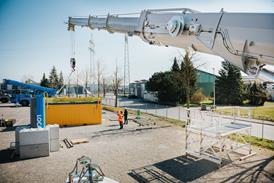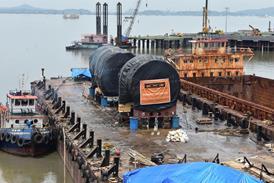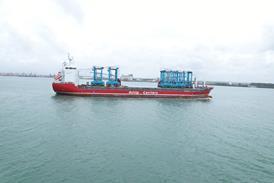September 22 - Nine Network, one of the most watched television stations in Australia, turned to Metcalf Crane Services to install a 2.8 tonne satellite dish on top of its 61 m new high-tech, purpose-built studios in Melbourne to transmit from the new sit
"The task of lifting the satellite was made comparatively simple because of the planning that went into the job," says Tim Metcalf, director of Metcalf Crane Services, who owns and operates Terex crane equipment. "The satellite system was designed by RG Systems, and because of the parameters of the project, the building manager at Nine Network recommended RG Systems have us do the installation."
To install the 15 m diameter dish on the roof, the satellite actually needed to be lifted 80 m up and over the building. Metcalf's 6-person crew relied on a combination of two Terex cranes, an AT-20 pick-and-carry crane and an AC 350 all-terrain crane, to lift the dish from the truck bed and into position on the building's rooftop in just four hours.
"This project faced some unique challenges, including traffic management restrictions," recalls Metcalf. "Because Bourke Street and Aurora Lane had to be closed down during the installation, we had to gain approval from the Melbourne City Council, and the entire project had to be completed in a 14-hour shift, including mobilisation and demobilisation."
High winds and the all-glass design and structure of the new studios, further complicated the delicate lift. "My crane operators had to closely monitor the anemometer to confirm the wind speeds and make adjustments accordingly," mentions Metcalf.
With the new satellite in place, the GTV-9 studios are now equipped to handle day-to-day operations, including the news and commercial sales, as well as to record larger scale studio productions.
Cranes Involved
After evaluating the parameters of the project, Metcalf chose a Terex® AT-20 pick and carry crane and a Terex® AC 350 all-terrain crane for the lift. "This project required specialised equipment, and these Terex cranes were ideal because of their exceptional lift radius and height capabilities," says Metcalf.
The AT-20 was used early in the lift. This Terex pick and carry crane lives up to its name - it has the strength to pick heavy loads, like large capacity satellite dishes, and the manoeuvrability to operate in tight spaces, including in and around existing infrastructures like the new GTV-9 office building. The AT-20 offered Metcalf's crew powerful performance and high productivity with 40 degrees articulation each side of centre which provides a total of 80 degrees of slewing arc. This unit's exclusive park brake attachment allows operators to slew the crane through 80 degrees while it is stationary and the single wheel parking brake is activated.
Metcalf's crew primarily used the AC 350 in the satellite dish installation lift. The entire Terex all-terrain crane line is designed for excellent mobility and versatility on any project, and the AC 350 lived up to that reputation. The variable steering with rear-axle steering offered Metcalf's operator excellent manoeuvrability for fast positioning around the GTV-9 building. With a total length of only 16.7 m (54.8 ft), the AC 350 is the smallest, most compact 6-axle mobile crane in the 350-tonne class, says Terex.
For the precision placement of components on tall structures, the power and lift capacity of the AC350 had the job well covered. The AC 350 features a state-of-the-art automatic transmission with 16 forward and two reverse gears. For this job the configured boom system gives the AC 350 a lifting height of 51.9 m (170.3 ft) from the main boom at 82 degrees. Equipped with a patented 61 m (200.1 ft) luffing fly jib, Metcalf's AC 350 can achieve 115.9 m (380.2 ft) of lifting height.















